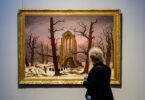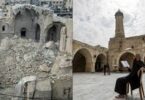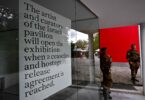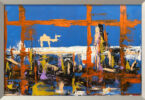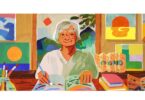Razmig Bedirian
The Museum of Islamic Art will reopen following an enhancement project and an overhaul of its permanent collection galleries, Qatar Museums has announced.
The museum is one of the leading institutions dedicated to Islamic art and will welcome visitors from October 5, in time for the influx of tourists and football fans heading to Doha for the Fifa World Cup, which begins in November.
The redesign has been carried out with the aim of making the museum more of an accessible, engaging and educational experience.
:quality(70)/cloudfront-eu-central-1.images.arcpublishing.com/thenational/255UL7OWALR7V256RFXENB4TNQ.jpg)
More than 1,000 objects will be going on display at the museum for the first time, most of which are newly conserved or acquired, alongside pieces that the institution has long been known for.
The collection galleries will feature a comprehensive visitor trail, offering interpretative materials that will help contextualise the artworks as well as interactive displays and multi-sensory applications to make the museum more accessible for families and younger guests.
The galleries will be organised according to historical and cultural themes, periods and geography. They will explore the great traditions of Islamic craftsmanship. The museum will also introduce a new section on Islam in South-East Asia and focus on the cultural exchange within the Islamic world and beyond.
Baghdad: Eye’s Delightwill be one of the first temporary exhibitions presented. Taking place between October 26 and February 25, the exhibition will explore and celebrate Baghdad’s heritage as the capital of the Abbasid caliphate, which ruled between 750 and 1258.
The exhibition will also highlight its legacy in the modern era, when the city again became an artistic, cultural and commercial hub in the 20th century. The display will comprise 160 objects, including works loaned from major institutions around the world.
:quality(70)/cloudfront-eu-central-1.images.arcpublishing.com/thenational/ONPZSK5BVYTWFD7XOYFQILCBDE.jpg)
The reopening comes as part of the year-round cultural initiative called Qatar Creates. The museum, which opened in 2008, is built on one end of the Corniche in Doha. It was the first intuition to launch by Qatar Museums under the leadership of its chairwoman Sheikha Al Mayassa Al Thani.
The museum was designed by internationally acclaimed Pritzker Prize-winning architect IM Pei.
“The opening of the Museum of Islamic Art was a transformational moment for Qatar, marking the nation’s emergence as a new global cultural destination and paving the way for establishing other major museums and cultural institutions in the region,” Sheikha Al Thani said.
“We are excited for locals to have a chance to rediscover the museum, and we invite visitors who are coming to attend World Cup matches to experience this foremost expression of our heritage and culture.”
“I am honoured to lead this extraordinary institution into its next chapter,” Julia Gonnella, director of the museum, said. “This enhancement will benefit generations of visitors, providing an even more meaningful experience and allowing guests to explore the rich vast history of the Islamic World as told through our unparalleled collection.”
What to expect from the redesign of the Museum of Islamic Arts?
The new visitor experience will begin on the ground floor with an introduction to the museum itself. A new space has been dedicated to the making of the museum, whereas the former majlis has been transformed into an immersive gallery for visitors to learn more about what inspired its architecture.
Some of the museum’s greatest artefacts will be housed in the first gallery on the second floor, including the Blue Quran, the Cavour Vase, the Varanasi necklace, the Ramayana manuscript of Hamida Banu Begum, and the Franchetti Tapestry.
:quality(70)/cloudfront-eu-central-1.images.arcpublishing.com/thenational/P2JWJ4BCDOQVDIYB4E62DHWVPE.jpg)
This is followed by an exploration of the origins and spread of Islam, with galleries devoted to the Quran and its history, the Muslim community (umma), learning and education within Islamic cultures and an examination of the expansion of Islam to both the East and West.
Visitors will then follow the historical events that led to the establishment of the caliphate, its expansion eastward into Iran and Central Asia, the development of courtly culture in Al-Andalus and survival of Islamic heritage in post-Islamic Spain.
The new arrangement of galleries will also illustrate the variety of materials used in Islamic art, including carpets and textiles, manuscripts, ceramics, wood, ivory, metalwork, stone and glass. The pieces date from the earliest Islamic period to the 20th century, spanning Spain and North Africa to the Far East.
Highlights from these galleries include early Hijazi Quran fragments, the sitara of the Holy Kaaba, the Moroccan arch, a copy of al-Sufi’s treatise on the fixed stars, the Abbasid blue-and-white bowl, the Seljuq stucco panel, the Doha Hind and the post-Islamic Spanish ceiling.
Level three journeys through the Islamic world from the Mediterranean in the West to the Indian Ocean in the East and beyond. The floor will explore the arts and societies from the 11th to the 19th centuries.
The main galleries focus on the three Gunpowder empires: the Ottomans, who ruled from Turkey over much of the Arab lands; the Safavids in Iran; and the Mughals in South Asia. On view are carpets from the Safavid period, a collection of Mughal jewels, and a display of Ottoman Iznik pottery and tilework.
These are accompanied by displays of Islamic manuscripts, arms and armour, concluding with galleries dedicated to China and South-East Asia, the latter a subject not typically presented in Islamic art museums.
Artefacts from the Cirebon shipwreck, jade vessels, Indonesian gold jewellery and textiles are among the key objects on view. Level three also explores hospitality — showcasing a newly conserved 19th century Syrian interior from a Damascus home, which served as a multifunctional microcosm of Ottoman life.
To celebrate its reopening, Qatar Museums and Thames & Hudson have co-published a catalogue dedicated to the history and collection of the Museum of Islamic Art.
Courtesy: thenationalnews

